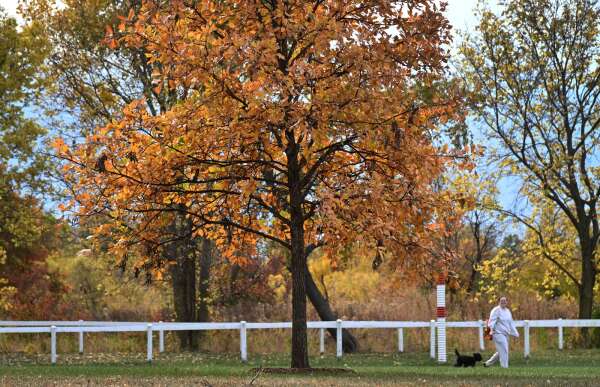Fall colors near the DuPage County Forest Preserve headquarters in Wheaton on Naperville Road.
Paul Valade/Daily Herald, Oct. 23, 2024
Millions of people across the northern United States will soon get a taste of fall as an air mass from northern Canada sweeps across the country this weekend through next week. It should also bring a brief break from hurricane risks near the coast.
Toward the end of the month, parts of 45 contiguous states are expected to experience below-average temperatures for this time of year, following what has been an unusually hot and humid summer – especially at night – for much of the country.
The change in weather is also linked to Hurricane Erin, whose northward movement across the Atlantic into next week will cause pressure cells to reshuffle across the Northern Hemisphere, allowing cooler air to filter into the central and eastern United States while Alaska as well as the West Coast – especially the Northwest – heats up and wildfire risks rise.
Over the past week, unusually warm air pooled across the high latitudes of the Northern Hemisphere. An overnight low temperature of 63 degrees Fahrenheit (17.2 degrees Celsius) in Greenland tied the highest minimum temperature ever recorded there, according to climate historian Maximiliano Herrera.
The upcoming plunge of cool air into midlatitudes will press pause on astronomical summer, which ends on Sept. 22 this year.
Temperatures will dip into the 40s and 50s by night and only rise into the 60s and 70s by day across many northern states – more typical of late September and the coolest since May in some areas – while the Mid-Atlantic and Southeast will see humidity levels plummet.
When, where and how cool it will get
The cool air mass will reach the eastern Rockies, Plains and Midwest this weekend.
On Sunday, high temperatures in Minneapolis will only be in the upper 60s, more typical of late September and early October.
Cities including Milwaukee and Chicago will notice the cooler weather starting Sunday. On Monday, high temperatures will only top out around 70.
On Monday and Tuesday, cooler conditions will spread east and south, reaching the Great Lakes, Northeast and Mid-Atlantic.
Cleveland and Buffalo will have highs in the upper 60s on Tuesday.
East of the Appalachians, northwesterly winds will warm as they glide down toward the coast. When combined with plentiful sunshine, this will prevent places from New York to Washington, D.C., from feeling overly fall-like, with midweek highs topping out around 80 degrees and very low humidity.
For the Southeast, a drop in humidity will be the most noticeable change, arriving on Tuesday or Wednesday. This may be an opportunity for people to turn off their air conditioners and open up windows.
The cooler change will fail to reach the Gulf Coast and Florida; the cold front will fizzle out as it clashes with the unusually warm waters of the Gulf of Mexico.
By night, temperatures will be even chillier. Parts of many northern states will dip into the 40s for the first time since May.
How long will it last?
Cooler than average air is set to stick around into early September.
While temperatures won’t necessarily be below-average every day, unusually hot weather is not expected to make weather headlines for most of the country outside of the West, Gulf Coast and Florida.
But it doesn’t mean that summer is over.
More hot, humid weather could return to the East Coast by the second week of September as the Bermuda high – a dome of Atlantic high pressure – flexes its muscles once again, sending tropical air northward.

Gerald Steele is the founder of Stonegate Health Rehab. He shares expert insights, recovery tips, and rehab resources to support individuals on their journey to wellness.
